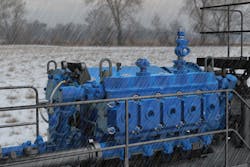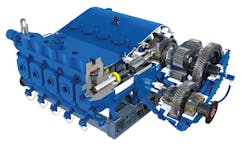Increasing pump durability in the oil field
The oil field is an incredibly demanding and hazardous environment that is notoriously tough on equipment. Today’s hydraulic fracturing operations present even greater challenges with longer laterals, multi-well pads, and harsher environmental restrictions. As required operating hours and increasing rod loads exceed the capabilities of traditional, intermittent-duty frac pumps, durable and cost-effective solutions become imperative to achieve success.
Historically, frac pump designs and the resulting technology have been slow to change in the industry. Typically, frac pump manufacturers make only incremental improvements to existing designs, and those improvements are often limited because of the constraints inherently imposed by the existing footprint they must stay within. These limitations translate to performance constraints and greater costs of ownership in the field while rarely addressing customers’ needs.
Achieving continuous duty
The goal in creating a continuous-duty pump was to develop a frac pump that would provide the best durability, cost-efficiency, reduced downtime and full rod load operation — 100 percent of the time — by challenging all previously imposed restrictions.
When evaluating how to achieve 100 percent runtime, understanding the weaknesses of existing equipment was essential. The three most common failure modes experienced with frac pumps include lubrication, structural rigidity and undersized components.
Lubrication is of significant concern because lubrication contaminants inherent to mechanical systems affect the life of the power end, especially the bearings. Lubrication oil becomes contaminated in two primary ways. These include contaminants that are generated from internal wearable components through typical wear and tear within the power end and airborne particles and sand that enter the pump on-location.
With respect to structural rigidity, the majority of frame failures typically start at the weld. Failure occurs for a multitude of reasons including a poor-quality weld that is either difficult to reach or does not have the correct weld geometry and design, a weld located in a high-stress area or a weld that does not follow established industry best practices.
We found that structural rigidity and alignment could be greatly improved to protect the power end by optimizing the frame design to place welds in low-stress areas and to utilize an engineered skid to reduce pump deflection under load. Additionally, doubling the mounting feet from four to eight created more structural stability. Alignment was also improved by stabilizing the gearbox, enhancing dimensioning and tolerance throughout the pump and by utilizing dowel pins to align the fluid end and power end with precision.
Design reimagined
Each component has unique pressure and flow requirements. Continuing to make incremental changes to an existing pump design forces the engineering team to concede in certain areas that could otherwise be optimized. As such, either the load capacity is constrained by the undersized dimensions or the materials needed are not practical for the application. Starting with a fresh design from the ground up provided a much-needed new perspective. The new approach allowed industry experts to reimagine a bearing that would satisfy the durability goals required to align with major engine and transmission overhauls. Since the bearings are the starting point for a successful design, the frame and remaining parts of the frac pump were built around the bearings to provide proper support. The in-depth analysis determined that the stiffness of the frame plays a pivotal role in a roller bearing’s lifetime wear. Rather than use undersized parts, increasing the size of key components, including shell bearings, roller bearings, crankshaft and crossheads, enabled the pump to handle greater loads. These critical design changes lowered stress up to 30 percent in critical areas and extended life beyond typical engine and transmission overhauls.
Further investigation into bearing life culminated in the creation of a patented dual-pressure, on-board oil filtration system designed to deliver clean oil to enhance bearing life. By employing high-pressure/low-flow lubrication for shell bearings and the bottom of the crosshead while simultaneously utilizing low pressure/high-flow lubrication for gears, roller bearings, knuckle bearings and the top of the crosshead, an optimized lubrication flow could be realized. This also eliminates metal-to-metal contact and removes heat to protect the pump and significantly enhance durability, while the custom filtration solution ensures that debris does not artificially shorten the life of these components.
Internal sources of contamination were eliminated with components appropriately sized for load and use. Additionally, replacing gaskets with O-ring seals improved the sealing of the power end, addressing one of the major pain points of operators – leaky gaskets. Helping customers and integrators create cleaner safer working environments along with improved filtration systems and oil cleanliness specs made a measurable difference.
The introduction of novel technology has dramatic implications for field operations. By improving structural rigidity, alignment, lubrication and right-sizing components for continuous duty, operators can realize a 17 percent decrease in ownership costs compared to conventional frac pumps with fewer pumps on the site, less nonproductive time and greater durability. Not only is this approach designed to allow equipment to last more than two times longer than the life of a legacy quintiplex pump with fewer interruptions for maintenance, it also enables it to do more work per hour.
The resulting design is the industry’s first high-horsepower frac pump built for 100 percent capacity all the time, capable of running 24 hours per day, seven days per week. It works in all regions and pressures, allowing operators maximum flexibility and it provides a platform that will respond as duty cycles trend harsher. The reduced footprint cuts the amount of consumables that must be taken to sites, which could ultimately reduce the amount of operators needed and lower maintenance costs. Customer feedback indicates the diminished vibration in the pump prolongs the life of iron and manifold trailers, providing even greater cost savings.
A modern solution
Today, frac operations are more demanding on surface equipment than ever before. Continually increasing lateral lengths and many wells per pad require frac operation units to run 24 hours per day at duty cycles harsher than anyone could have dreamed about just a few years ago. That kind of demand reduces equipment life and efficiency. Legacy frac pumps were not designed to run at peak rod loads under round-the-clock operation, so they must be throttled back to reliably complete the job. This results in reduced available horsepower and requires more equipment at the well site to effectively stimulate shale formations.
The high-horsepower frac pump is built for continuous duty at 275,000 pound-force rod load capable of running 24 hours per day, seven days per week. It is designed to provide customers years of safe, reliable operation with lower total costs and minimal nonproductive time. The introduction of the continuous-duty frac pump allows inefficiencies to be eliminated and ushers in an era of true 24/7 operations.
Bryan Wagner is the director of engineering for Weir Pressure Pumping. He joined Weir in 2014 and coordinates engineering, product development, and strategic technology activities for pressure pumps, high-pressure flow iron and related components. Wagner has spent most of his career in the oil and gas sector, specifically in engineering, product management and R&D. He holds a Bachelor of Science in mechanical engineering from the University of Akron. Learn more at global.weir.


